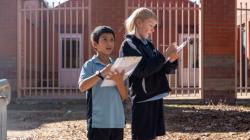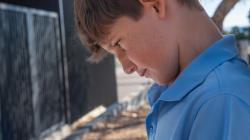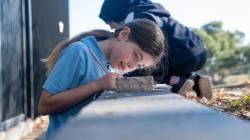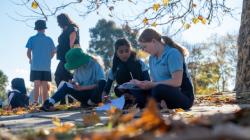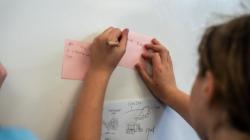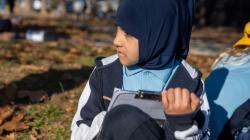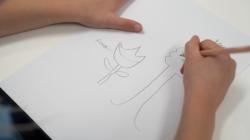'SUSTAIN THE CHAIN' IS ONE OF OUR NEW TEACHING SEQUENCES FOR AC V9
- On the 'Sequence overview' tab you'll find all the lessons in this sequence and curriculum alignment.
- The 'Our design decisions' tab shows how key scientific ideas develop over the sequence, and shows how the sequence addresses curriculum achievement standards.
- The 'Preparing for this sequence' tab guides you through important information and considerations for this sequence.
- Have you taught this sequence? Use the Feedback button to let us know how it went!
Launch
Lesson 1 • Our local environment
Students explore the roles and interactions of consumers, producers and decomposers within a habitat by identifying how scientific knowledge can be used to support the development of the local environment.
Inquire
Lesson 2 • Follow the chain
Students explore and identify the key features of an organism’s habitat. They use a labelled diagram of a plant or animal to describe how it is interdependent on other living organisms.
Lesson 3 • Ant picnic
Students use the scientific process to identify the preferred food of ants. They discuss the mutually beneficial relationship between plants and ants.
Lesson 4 • Producers and consumers
Students identify the key features of producers and consumers, and use arrows to describe the movement of energy along a food chain.
Lesson 5 • Food chains
Students explore a model of a food chain. They gather data that outline how food, shelter, predators and water affect the survival of a kangaroo population and use a graph to explain their observations.
Lesson 6 • Decomposers and detritivores
Students explore and identify the effects of a decomposer on fruit. They identify the sequence of events that occur during decay and test for the presence of decomposers in their local environment.
Lesson 7 • Changing habitats
Students investigate the impact of introduced organisms in a food chain through modelling. They examine how science knowledge can be used to solve a problem of an introduced plant in the Northern Territory.
Act
Lesson 8 • Habitat stewards
Students use their knowledge of the local habitat to design a product for the classroom context, and communicate it to an audience.
The Australian Academy of Science supports and encourages broad use of its material. Unless indicated below, copyright material available on this website is licensed under a Creative Commons Attribution-NonCommercial-ShareAlike 4.0 International (CC BY-NC-SA 4.0) licence.
Curriculum and syllabus alignment
Achievement standards
By the end of Year 4 students identify the roles of organisms in a habitat and construct food chains. They explain the role of data in science inquiry. They identify solutions based on scientific explanations and describe the needs these meet.
Students pose questions to identify patterns and relationships and make predictions based on observations. They plan investigations using planning scaffolds, identify key elements of fair tests and describe how they conduct investigations safely. They use simple procedures to make accurate formal measurements. They construct representations to organise data and information and identify patterns and relationships. They compare their findings with those of others, assess the fairness of their investigation, identify further questions for investigation and draw conclusions. They communicate ideas and findings for an identified audience and purpose, including using scientific vocabulary when appropriate.
Australian Curriculum V9 alignment
Science as a human endeavour
Science understanding
Explain the roles and interactions of consumers, producers and decomposers within a habitat and how food chains represent feeding relationships
Science inquiry
Pose questions to explore observed patterns and relationships and make predictions based on observations
Use provided scaffolds to plan and conduct investigations to answer questions or test predictions, including identifying the elements of fair tests, and considering the safe use of materials and equipment
Follow procedures to make and record observations, including making formal measurements using familiar scaled instruments and using digital tools as appropriate
Construct and use representations, including tables, simple column graphs and visual or physical models, to organise data and information, show simple relationships and identify patterns
Compare findings with those of others, consider if investigations were fair, identify questions for further investigation and draw conclusions
Write and create texts to communicate findings and ideas for identified purposes and audiences, using scientific vocabulary and digital tools as appropriate
Australian curriculum content links
| Science understanding core concept: Biological systems are interdependent and interact with each other and their environment. |
| Sub-strand | Content descriptor | AC code | Achievement Standard | How the sequence addresses this content |
| SHE: Nature and development of science | Examine how people use data to develop scientific explanations. | AC9S4H01 | Explain the role of data in science inquiry. | Model the impact of factors in kangaroo populations. (Lesson 5) |
| SHE: Use and influence of science | Consider how people use scientific explanations to meet a need or solve a problem. | AC9S4H02 | Identify solutions based on scientific explanations and describe the needs these meet. | Describe how students used their understanding of a food chain to help farmers remove an invasive weed. (Lesson 7, optional) |
| SU: Biological sciences | Explain the roles and interactions of consumers, producers and decomposers within a habitat and how food chains represent feeding relationships. | AC9S4U01 | Identify the roles of organisms in a habitat and construct food chains. | Describe the roles of producers and consumers in a habitat and construct a variety of food chains. (Lessons 4, 5, 6, 7 and 8) Describe the effects of an introduced species of different food chains. (Lesson 7) |
| SI: Questioning and predicting | Pose questions to explore observed patterns and relationships and make predictions based on observations. | AC9S4I01 | Pose questions to explore patterns and relationships and make predictions based on observations. | Pose questions that explore patterns and relationships between living things in a habitat. (Lessons 2 - 8) |
| SI: Planning and conducting | Use provided scaffolds to plan and conduct investigations to answer questions or test predictions, including identifying the elements of fair tests, and considering the safe use of materials and equipment. |
AC9S4I02 | Plan investigations using planning scaffolds, identify key elements of fair tests and describe how they conduct investigations safely. | Use a scaffold to plan a fair test into the preferred foods of ants and the use of modelling to investigate the effects of limited food, shelter and water on a kangaroo population. (Lessons 3, 5) |
| SI: Planning and conducting | Follow procedures to make and record observations, including making formal measurements using familiar scaled instruments and using digital tools as appropriate. | AC9S4I03 | Use simple procedures to make accurate formal measurements. | Use story boarding to make accurate measurements of the preferred foods of ants and the use of modelling to quantitatively measure the effects of limited food, shelter and water on a kangaroo population. (Lessons 3, 5) |
| SI: Processing, modelling and analysing | Construct and use representations, including tables, simple column graphs and visual or physical models, to organise data and information, show simple relationships and identify patterns. | AC9S4I04 | Construct representations to organise data and information and identify patterns and relationships. | Organise information in tables and graphs to identify relationships and patterns in varying the size of a population. (Lesson 5) |
| SI: Evaluating | Compare findings with those of others, consider if investigations were fair, identify questions for further investigation and draw conclusions. | AC9S4I05 | Compare their findings with those of others, assess the fairness of their investigation, identify further questions for investigation and draw conclusion. | Work collaboratively to identify the strengths and weaknesses of their own and others’ investigations and habitat modelling including where testing was not fair, and practices could be improved. (Lesson 3) |
| SI: Communicating | Write and create texts to communicate findings and ideas for identified purposes and audiences, using scientific vocabulary and digital tools as appropriate. | AC9S4I06 | Communicate ideas and findings for an identified audience and purpose, including using scientific vocabulary when appropriate. | Students communicate their understanding of food chains and habitats to an audience of peers and invited guests in a classroom context selected by the teacher. (Lesson 8) |
Science journals
Create a class science journal, either in hard-copy or digitally. You might:
- use/create a large scrap book or flip chart.
- use poster/butchers’ paper so learning can be displayed in sequence on the wall.
- create a digital journal using your platform/technology of choice.
- any combination of the above.
Plan for students’ creation of an individual science journal, either in hard-copy or digitally. They might:
- use an exercise book, scrap book or flip chart to record their thinking and gather resource sheets together.
- use a folder to store and collate resource sheets, diagrams, photographs etc.
- use a digital folder to store work samples, images and videos.
- any combination of the above.
See Using a science journal throughout inquiry for more detailed information on the importance of science journals.
Adapting to your context
This teaching sequence was designed to be modified to suit the context of individual classes. Four possible options are provided:
- Local bushland or parkland: writing a field guide for future students or locals
- School vegetable garden: deciding what to plant in the next season
- School garden: identifying how to encourage diversity of local birds and insects
- See the ABC article Designing a habitat garden for an example of this.
- School compost bin or worm farm
Determine which of these options is most suitable for your students' and school context.
Each of the lessons provided cover the content and skills outlined in the Australian Curriculum V9 for each of these contexts. This allows modifications of the Launch phase and Act phase across different classes or in successive years.
Additional preparation
- Read through the teaching sequence.
- The equipment list contains the maximum number of each piece of equipment that will be required across the teaching sequence. Some lessons may not need the full number that is listed.
The materials required for each lesson are listed on the lesson's page. For the full sequence resource list, download the Preparing to teach this sequence document below.

